Business Process Re-engineering and ERP System Implementation in Design Company
on
JITTER- Jurnal Ilmiah Teknologi dan Komputer Vol. 3, No. 1 April 2022
Business Process Re-engineering and ERP System Implementation in Design Company
Ranggashakti Bimantaraa1, I Putu Agung Bayupatia2, Ni Kadek Rusjayanthia3 aInformation Technology Study Program, Faculty of Engineering, Udayana University Bukit Jimbaran, Bali, Indonesia, Phone. (0361) 701806
e-mail: 1ranggasb9@gmail.com, 2bayupati@unud.ac.id, 3dwi.rusjayanthi@unud.ac.id
Abstrak
Integrasi data dan informasi memiliki peranan penting dalam bisnis yang perlu dimiliki oleh setiap pelaku usaha untuk dapat bersaing di era digitalisasi. CV.Triloka merupakan perusahaan di bidang jasa desain dan pembangunan yang kini sedang berkembang pesat namun belum memiliki sistem yang mumpuni dan saling terintegrasi. Kegiatan operasional perusahaan masih dilakukan secara manual tanpa menggunakan sistem terintegrasi yang menyebabkan penurunan performa kerja karena tidak efisien. Berdasarkan permasalahan tersebut, dilakukan perbaikan proses bisnis yang dimulai dari tahap analisa hingga implementasi dengan memanfaatkan sistem Odoo agar menghasilkan proses bisnis yang best practice sesuai dengan Enterprise Resource Planning (ERP). Hasil dari penelitian berupa hasil analisa proses bisnis existing, proses bisnis baru, implementasi modul-modul Odoo dan hasil kuesioner implementasi sistem.
Kata kunci: Integrasi, ERP, Odoo, Implementasi, Modul
Abstract
Data and information integration has an essential role in a business that every business actor needs to compete in the digitalization era. CV. Triloka is a company in design and development services that are currently proliferating but does not yet have a capable and integrated system. The company's operational activities are still carried out manually without using an integrated system which causes a decrease in work performance due to inefficient. Based on these problems, improvements were made to business processes from analysis to implementation by utilizing the Odoo system to produce best practice business processes following Enterprise Resource Planning (ERP). The research results are in the form of analysis of existing business processes, new business processes, implementation of Odoo modules, and results of system implementation questionnaires.
Keywords : Integration, ERP, Odoo, Implementation, Module
Business competition in the design and development service industry requires business actors to have clear business processes and strategies to compete with competitors [1]. ERP is an information integration and coordination application used by a company to facilitate the distribution of information across its business areas [2]. The application of ERP in carrying out the company's business processes is not only to improve performance but also to be able to compete in the current Industrial Era 4.0, as in a study entitled "Implementation of an ERP-Based Warehouse Management Information System using the Odoo Application" which aims to increase value and effective business on business [3].
The problem faced in the research "Implementation of Odoo for Managing Safety Stock in Clothing Retail Industry" is that making purchase orders for goods is still done manually, so there are often errors in the amount of stock ordered because it does not adjust to demand, which results in a decrease in sales and delays in the process. The solution to this problem is to create an automatic purchase order system based on existing requests using Odoo. The availability of goods is more scheduled by developing BPM (Business Process Management) [4].
Business process improvement was also carried out in a study entitled "Implementation of an Odoo-Based ERP System Sales Module with the RAD Method at PT XYZ." ERP system implementation is carried out in the marketing division to improve business processes in the division. The system is designed using the RAD (Rapid Application Development) method. Research after implementation is also carried out using the User Acceptance Test method to determine whether the system follows user needs [5].
ERP systems can also be used for company sales management as in the research entitled "Implementation of ERP on Sales Management Module using Odoo 11". The ERP system implementation process begins with the Odoo server installation process, database creation, installation of the required modules, and adjusting to pre-determined applications and requirements [6].
Problems arise because companies or agencies that have not used an integrated system can interfere with the performance and performance of the company. This study aims to improve work performance and maintain CV data and information security in CV. Triloka by improving current business processes using best practice ERP systems. This study uses the Odoo open-source ERP system to achieve the research objectives. Access to data and information quickly and accurately is evidence of technological developments and the use of computers as information media which has an important role in system development [7]. Implementing an ERP system can also provide added value for the company and affect customer trust and in competing with other companies [8].
The method used in this research consists of several stages, namely problem identification, literature study, data collection, data analysis, data processing, system implementation testing, and conclusions and suggestions.
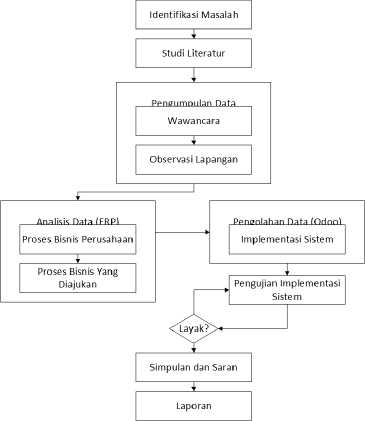
Figure 1. Research Method
The first stage is problem identification. Problem identification is made to discover the company's problems through data collection, namely direct interviews with companies and analysis. The second stage is literature study. A literature study was conducted to collect theories that can be used to answer research problems. Literature studies are taken from related journals and books. The third stage is data collection. Data collection is carried out to collect data and information about the company used for problem identification. The fourth stage is data analysis. Data analysis is carried out to process the data and information that has been obtained to create an overview of how business processes are running and can run BPR following best practices using the ERP system.
The fifth stage is data processing. Data processing is carried out in the form of an ERP system implementation that has been designed based on the results of data collection and analysis—the ERP system used at Odoo. The implementation of Odoo in this study uses Odoo
Community version 14 because it is free and free to modify. The modules implemented based on the analysis results are the Sales, Accounting, Project, Employee, Payroll, and Purchase modules. The sales module is used to design order transactions with customers. The Accounting module manages incoming and outgoing funds from customers, vendors, and employees. Project module as a place for project management. Personnel Module as a forum for employee management. Payroll module is a place to manage employee payroll, and the Purchase module is a place for open tender transactions with vendors (builders).
The last is the system implementation test which is carried out to determine the level of user acceptance in implementing the system to improve the company's business processes. The test uses the Technology Acceptance Model (TAM) method. The test is in the form of a questionnaire distributed to company employees who have tried to use the system.
The literature study contains general problems to explore methods and knowledge to adapt the Odoo system from previous books, articles, research reports, and journals.
Business Process Re-engineering (BPR) is a method that tries to discover how current business processes operate and how to redesign these business processes to eliminate wasteful activities. BPR is a fundamental rethinking and radical redesign of business processes to achieve dramatic improvements in critical contemporary performance measures, such as cost, quality of service, and speed [9].
ERP is a computer application with two essential characteristics: data integration and best practice processes [10]. ERP is the key to becoming global by linking demand and supply between countries using accurate data [11]. Enterprise Resources Planning is software that allows the creation of integrated and automated processes between various departments and entities within a company. Every activity carried out by any department is digitally recorded into a single database [12].
Enterprise Resource Planning (ERP) consists of business functional areas and business processes. A functional business area is a category of business process areas. A business process is a set of activities that take inputs and create valuable outputs for the company and its customers. ERP implementation in CV. Triloka includes integration between business processes such as the design of sales order information data that can be accessed by accounting, project, and purchasing parties to be used as data for invoicing, project planning, and open tendering.
Odoo is an open-source ERP system that can be used freely because it can be modified according to user needs. Odoo has many applications that can be used by small and large scale companies or agencies, such as integrated Sales, CRM, Accounting, Purchase, Manufacturing, and other applications. The existence of this cross-business integration is beneficial for companies to distribute data and information and store transaction data centrally and usually cloud-based so that it becomes faster and more efficient. Cloud data storage means making the internet a central server for processing data [13].
TAM is a method for assessing system acceptance using a behavioral theory approach. There are two main components or variables in TAM that influence the decision to use technology: Perceived Usefulness (PU) and Perceived Ease of Use (PEU). PU is defined as a variable to determine how users believe that the technology provides benefits and can improve its performance. PEU is defined as a variable to determine the level of user confidence that the technology is easy to implement [9].
The Likert scale is used to measure the respondent's attitude towards a statement developed by Likert in 1932. The Likert scale assumes that the strength of an attitude is linear
(from strongly agree to strongly disagree) and can be measured by providing several values used to measure attitudes studied.
|
Table 1. Likert Scale |
Table 2. Score Interval | ||
|
Number |
Criteria |
Interval |
Criteria |
|
1 |
Strongly Disagree |
0-19,99% |
Very Less |
|
2 |
Disagree |
20-39,99% |
Not good |
|
3 |
Neutral |
40-59,99% |
Enough |
|
4 |
Agree |
60-79,9% |
Good |
|
5 |
Strongly Agree |
80-100% |
Very Good |
Table I is an example of assigning a numerical score to each point of a Likert scale. The value of each issue is used to measure the interpretation value of the highest score (Y) using Formula 1. Table 2 is the criteria for the interval score that has been changed using Formula 4. Y = skala tertinggi Likert × jumlah responden (1)
Y is the highest score value sought by multiplying the highest Likert scale value used by the number of respondents. The lowest score interpretation value (X) measurement uses Formula 2.
X = skala terendah Likert × jumlah responden (2)
X is the lowest score that is sought by multiplying the highest Likert scale value used by the number of respondents. For example, this study uses 18 respondents with the largest scale strongly agreeing or 5, the highest score is 5 × 18 = 90, and the lowest score is 1 × 18 = 18. After getting the highest and lowest scores, the next step is to make the final assessment criteria using the method percent score interval (I) using Formula 3.
I= IOO ÷ jumlah skor Likert
(3)
If the number of Likert scores used is 5 points. Then I is 100 5 = 20. The interval criteria that can be used from 0%-100% can be seen in Table 2.
total skor . __
-------X 100
(4)
If the total score of points obtained from one statement is 69 and Y (the highest score) is 90, the calculation is 69/90x100 = 76.66%. The index value of 76.66% is included in the appropriate criteria.
The results and discussion contain an analysis of business process re-engineering obtained from research results and system testing results using TAM.
Process re-engineering in the company's business processes is the improvement of business processes from existing business processes that are carried out manually without using the system to become new business processes that utilize an integrated system. The
company's business process re-engineering aims to simplify and streamline work by simplifying system use with system automation and data integration.
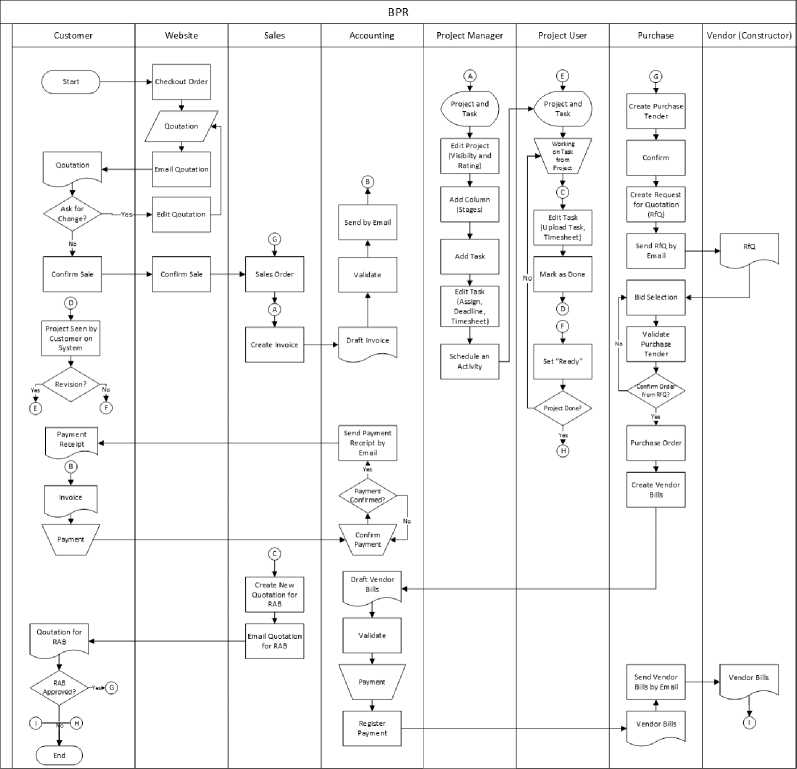
Figure 2. Company Business Process Re-engineering
Re-engineering the company's business processes includes the design order process, project management, and open tenders. Re-engineering of the design order process includes orders that can be made via the website and the automation of sales and accounting modules that make the payment process for design orders easier. Re-engineering in the project management process includes project work planning that can be scheduled on the system, and customers can view project work reporting in real-time. Re-engineering the open tender business process includes open tenders that can be done through the website and automation during the bidding process to shorten.

Figure 3. Example of Data Integration Between Modules
-
Figure 3 is an example of data integration between sales, invoices, and project modules. In the picture, it can be seen that there is information about invoice status, which is integrated with the invoice module, and the next activity, which is integrated with the project.
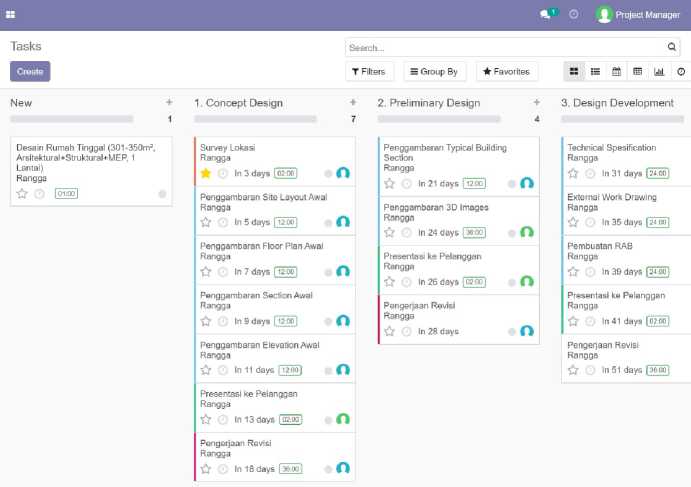
Figure 4. Project Work Scheduling
-
Figure 4 is an example of project scheduling in the Project module in the Odoo system. Project managers can create stages or stages of project work that are planned. The contents of each stage are tasks or activities in a stage.
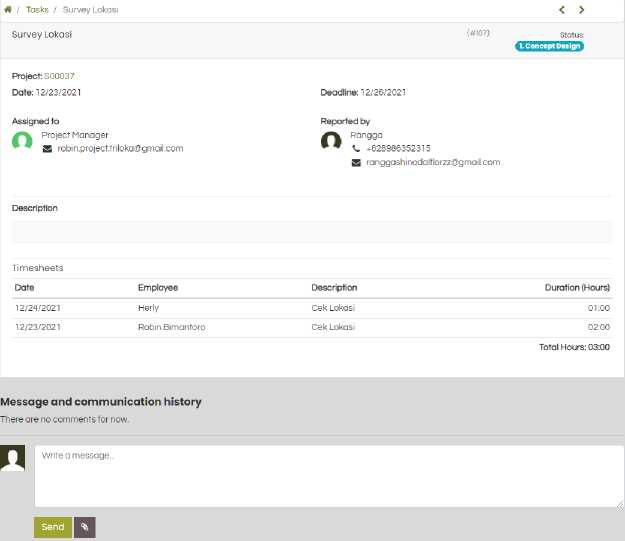
Figure 5. Reporting Project Work from Customer Accounts
-
Figure 5 is a display of project work reporting that can be accessed by the customer concerned. There is information about the activities carried out along with the timesheet or the time used to carry out these activities in the report. On the reporting page, customers can also communicate in real-time with project management to discuss the results of project work.
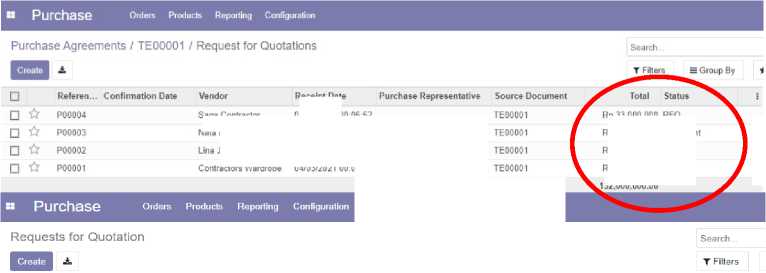
Contractors Wardrobe
Saga Contractor
Nala Konstruksi
Jaya
Receipt Date
04/03/2021 00.06:52
04/03/2021 00:05:48
04/03/2021 00:05:40
04/03/2021 00:04:59
Rp 33.0 00.00 0 RFQ
Rp 33,000.000 RFQSent
Rp 33.000,000 RFQ
Rp 33.000,000 RFQ
132,000,000.00

Figure 6. Example of Automation in the Purchase Module
-
Figure 6 is an example of automation in the purchase module during the bidding or Request of Quotation (RFQ) process. The bidding process is carried out by sending one bid to many vendors so that one tender has several RfQs. At the beginning of the bidding process, the status of the RFQ is “RFQ” or “RFQ sent” if the RFQ has been sent to the vendor via email. The purchasing party closes the bidding process by confirming one of the selected RfQs to automatically cancel all RfQs.
System testing is done after employees use the new system for their business processes. The trial conducted using TAM is a research model to predict an individual's decision to adopt a technology [12].
The assessment was carried out using a questionnaire containing 12 statements, 6 statements to measure the system's ease of use, and 6 statements to measure the system's usability in company activities. The questionnaire uses a Likert scale to get the value of the level of agreement with the proposed statement. The Likert scale assumes that the strength of an attitude is linear (from strongly agree to strongly disagree) and can be measured by providing a numerical value that is used to measure the attitude under investigation. The questionnaire consists of 6 statements of perceived usefulness (PU) and 6 statements of perceived ease of use (PEU). The TAM statement can be seen in Table 3.
Table 3. TAM Statement
Code Statement
PU1 ERP system makes work faster
PU2 ERP system makes work easier
PU3 ERP system can improve my work performance
PU4 ERP system can increase my work productivity
PU5 ERP system can improve my work effectiveness
PU6 ERP system is very helpful for my work
PEU1 ERP system is easy to use
PEU2 ERP system is easy to learn
PEU3 ERP system easily does what I want to do
PEU4 ERP system is very easy and easy to understand
PEU5 My interaction using ERP System is direct and easy to understand
PEU6 I am fast proficient in using the ERP System
The questionnaire was filled out by 18 respondents actively using the system. The results of the total calculation of the questionnaires obtained can be seen in Table 4.
Table 4. Total Score Result of Questionnaire Table 5. Final Ranking Results
Calculation
|
Perceived Usefulness |
STS 1 |
TS 2 |
N 3 |
S 4 |
SS 5 |
Perceived Usefulness |
Total |
Peringkat |
|
PU1 |
0 |
0 |
8 |
9 |
1 |
PU1 |
65 |
Baik |
|
PU2 |
0 |
0 |
10 |
6 |
2 |
PU2 |
64 |
Baik |
|
PU3 |
0 |
0 |
12 |
6 |
0 |
PU3 |
60 |
Baik |
|
PU4 |
0 |
0 |
14 |
4 |
0 |
PU4 |
58 |
Baik |
|
PU5 |
0 |
0 |
8 |
9 |
1 |
PU5 |
65 |
Baik |
|
PU6 |
0 |
1 |
7 |
9 |
1 |
PU6 |
64 |
Baik |
|
Perceived |
STS |
TS |
N |
S |
SS |
Perceived Ease |
Total |
Peringkat |
|
Ease of |
1 |
2 |
3 |
4 |
5 |
of Use | ||
|
Use |
PEU1 |
73 |
Sangat | |||||
|
PEU1 |
0 |
0 |
4 |
9 |
4 |
Baik | ||
|
PEU2 |
0 |
0 |
4 |
1 |
4 |
PEU2 |
73 |
Sangat |
|
0 |
Baik | |||||||
|
PEU3 |
0 |
1 |
10 |
6 |
1 |
PEU3 |
72 |
Baik |
|
PEU4 |
0 |
0 |
7 |
8 |
3 |
PEU4 |
61 |
Baik |
|
PEU5 |
0 |
1 |
6 |
8 |
3 |
PEU5 |
68 |
Baik |
|
PEU6 |
0 |
1 |
10 |
7 |
0 |
PEU6 |
67 |
Baik |
The total score results are indexed using a formula and ranked according to a Likert scale. The ranking results can be seen in Table 5. From these results, it is known that only two statements that got excellent results, namely PEU 1 and PEU2, with a total score of 73%, were ranked very well. With a total score of 58%, the lowest result was PU4, with a good rating.
The data collection and analysis results are in the form of information about existing business processes. Existing business processes are converted into new business processes or BPR following ERP best practices. The proposed new business processes include design ordering, project management, open tendering, and payroll business processes. The implemented Odoo modules are website, sales, and invoices for the design ordering business process. Project module for the project. Purchasing and invoicing module for open tender process—payroll module for employee payroll.
The results of the trial assessment using TAM found that overall, business process improvement and ERP system implementation were highly accepted by CV. three employees. Two statements rank very well, namely, on the ease of use of the PEU system and ease of learning. The lowest statement with an index of 58% is occupied by PU4, increasing work productivity using the system. Respondents stated that the system applied was still computerbased, so it could not be used outside the office, while most of the CV. Triloka employees work at the project site. This makes respondents not feel too helped by the system because of the mobility of employees who often work outside the office and must immediately report project work.
Referensi
-
[1] A. M. Amin, L. M. Baga, and N. Tinaprilla, “Strategi Perencanaan Model Bisnis Perusahaan Jasa Konsultan Arsitektur dan Jasa Kontraktor PT Architectaria Media Cipta,” MANAJEMEN IKM: Jurnal Manajemen Pengembangan Industri Kecil Menengah, vol. 13, no. 1, p. 55, Apr. 2018, doi: 10.29244/mikm.13.1.55-65.
-
[2] E. F. Monk and B. J. Wagner, Concepts in Enterprise Resource Planning, Fourth. Boston: Course Technology, 2013.
-
[3] E. Hanifah, “Implementasi Sistem Informasi Warehouse Management Berbasis Enterprise Resource Planning (ERP) dengan Menggunakan Aplikasi Odoo,” Universitas Muhammadiyah Surakarta, Surakarta, 2017.
-
[4] N. B. Pramana, I. P. A. Bayupati, and I. K. A. Purnawan, “Implementation of Odoo for Managing Safety Stock in Clothing Retail Industry,” International Journal of Computer Applications, vol. 177, 2019.
-
[5] Aziza, Safira, Rahayu, and G. H. N. Nur, “Implementasi Sistem Enterprise Resource Planning Berbasis Odoo Modul Sales dengan Metode RAD pada PT XYZ,” Journal Industrial Services, vol. 5, 2019.
-
[6] N. K. Y. Ristyawati, I. K. A. Purnawan, and G. M. A. Sasmita, “The Implementation of Enterprise Resource Planning (ERP) on Sales Management Module using Odoo 11,” International Journal of Trend in Scientific Research and Development (IJTSRD), vol. 4, no. 4, 2020.
-
[7] I. D. Made Adi Baskara Joni and I. P. H. Permana, “Pengelolaan Kegiatan Pengabdian Masyarakat dengan Sistem Informasi Manajemen,” Lontar Komputer : Jurnal Ilmiah Teknologi Informasi, p. 124, Aug. 2017, doi: 10.24843/LKJITI.2017.v08.i02.p06.
-
[8] P. P. Wrestra Saridewi, I. K. G. D. Putra, and I. M. Sukarsa, “Implementation of Enterprise Resource Planning at CV. Dewi Bulan,” Jurnal Ilmiah Merpati (Menara Penelitian Akademika Teknologi Informasi), vol. 9, no. 3, p. 226, Jul. 2021, doi: 10.24843/JIM.2021.v09.i03.p04.
-
[9] Hammer and Champy, Reengineering the Corporation: A Manifesto for Business Revolution. 1993.
-
[10] Prof. dr. L. Sneller, “A Guide to ERP: Benefits, Implementation and Trends.” Book Boon, bookboon.com, 2014.
-
[11] T. F. Wallace and M. H. Kremzar, ERP: Making It Happen. Canada: John Wiley & Sons, Inc, 2001.
-
[12] I. P. A. H. Pratama, I. M. Sukarsa, and G. A. A. Putri, “Reengineering of Manufacturing Business Process Utilising the Manufacturing Module of an ERP Application,” Jurnal Ilmiah Merpati (Menara Penelitian Akademika Teknologi Informasi), vol. 9, no. 3, p. 263, Oct. 2021, doi: 10.24843/JIM.2021.v09.i03.p07.
-
[13] P. S. Saputra, I. M. Sukarsa, and I. P. A. Bayupati, “Sistem Informasi Monitoring Perkembangan Anak di Sekolah Taman Kanak – kanak Berbasis Cloud,” Lontar Komputer : Jurnal Ilmiah Teknologi Informasi, p. 112, Aug. 2017, doi: 10.24843/LKJITI.2017.v08.i02.p05.
Discussion and feedback